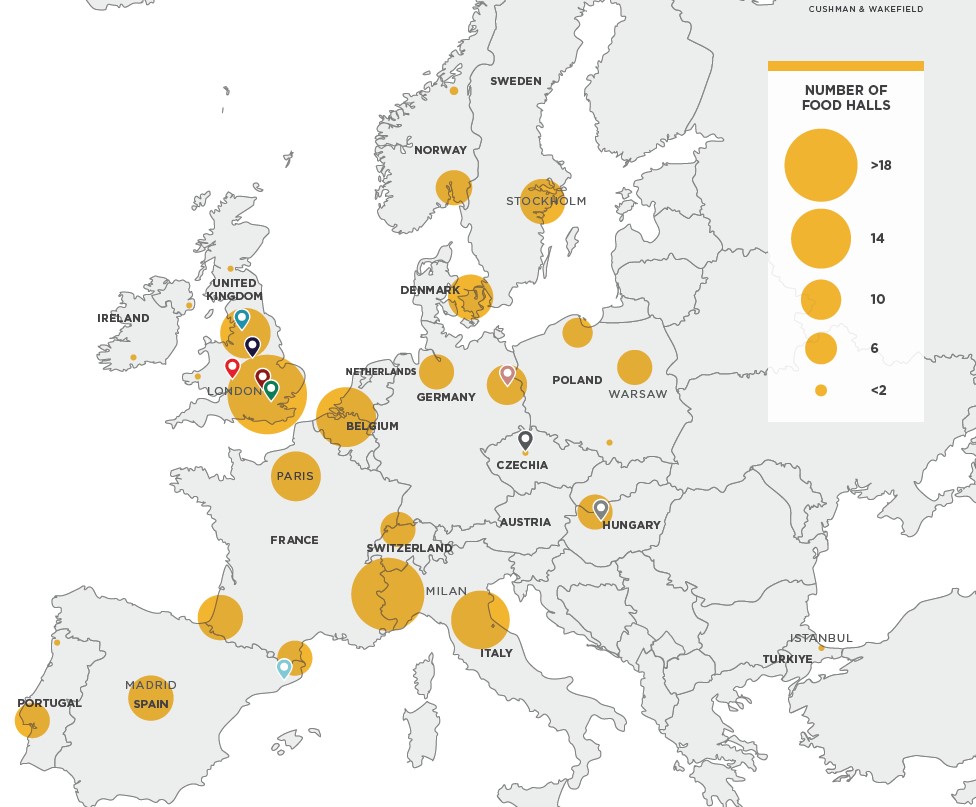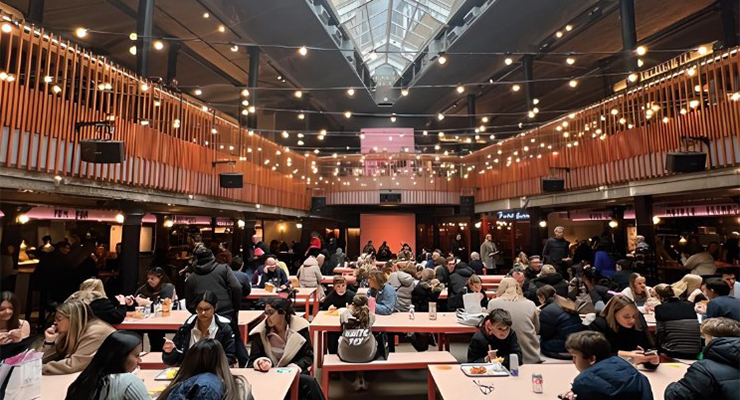This shift towards a more social-centric approach has resulted in an increased interest in food halls as a destination for leisure and gathering, rather than solely focusing on eating, though food remains the center of attention. Food halls offer a blend of choice and efficiency, distinct to the more rigid structure of traditional restaurants.
Since the commercial real estate broker´s last report in 2017, food halls have gone from hidden gems to must-visit destinations, dotting the urban landscape across continents. The rise in food halls speaks volumes about their ability to adapt to changing consumer preferences, foster community engagement and redefine the concept of eating out.
In Cushman & Wakefield’s 2017 Food Halls of Europe report, food halls were rapidly gaining popularity. Appealing to tourists, locals and office workers alike, it was noted how customers were seeking unique experiences, particularly driven by the younger, travel-savvy generation. Fast forward to today and these trends remain true – even withstanding a pandemic. COVID-19 underscored the importance of flexible social spaces, with consumers craving memorable experiences after prolonged periods of isolation.
“We opened Seven Dials in December 2019, so we only had a few months of trade before the pandemic”, shared Simon Mitchell, CEO of KERB Food. “In terms of our vendors, we were very supportive, pausing rent and gradually phasing it back in. Post-pandemic, footfall has been growing exponentially; 30,000 people visit a week, and it’s particularly busy in the evenings. KERB Street Food markets which feed office workers are down – we’ve had to close the Canary Wharf market at West India Quay as daytime footfall hasn’t returned”.
“Our Markets are more than just spaces; they’re hubs for entrepreneurs and local brands”, add Sandy Hayek, CEO of Time Out Market, and Chris Öhlund, CEO of Time Out Group. “Without them, we essentially don’t have Markets, so when we had to close it was a challenging time. Initially, there was uncertainty about the lasting effects of COVID-19 on people’s willingness to go out, but we were surprised to find the opposite.”
A Taste of Authenticity and Social Connection
Convenience has become paramount as people don’t want the hassle of booking, or arranging transportation. Food halls, with their community-centric model, have excelled in meeting this demand. Whilst lockdowns and unforeseen cost increases have meant that some food halls have had to make the tough decision to close their doors, the overall trend has been one of adaptability and growth.
More so than ever, consumers are now increasingly discerning about where they spend their money; they want their purchases to resonate with meaning and purpose, and food halls resonate with this sentiment. These vibrant spaces not only provide a variety of culinary delights but also prioritise authenticity, locality and sustainability, placing social importance at their core. In essence, the continued rise of food halls encapsulates these shifting consumer behaviours since they serve as more than just dining destinations – they represent a cultural movement towards conscious consumerism.

Two Outstanding Markets: The UK and Italy
Currently, European food halls number around 135, with the majority being located in the UK and Italy. In case of the UK, it has experienced a significant expansion of food halls, with London typically being the experimental city. There is a notable trend towards creating engaging social environments where these modern food halls go beyond traditional dining and focus on providing a vibrant and interactive atmosphere for customers.
In Italy, there is a strong emphasis on fresh and locally sourced ingredients, highlighting the country’s culinary heritage. Offering a wide selection of fresh produce such as cheese and cured meats as well as non-food items like flowers, food halls in Italy are more oriented as markets attracting visitors who are looking for genuine products.
“The food hall business is in desperate need of scalable operations”, told Martin Barry, Founder and CEO of Manifesto Market, to Cushman & Wakefield when asked about the concept´s future. “There’s probably around 250 food halls, around 100 in the pipeline, but only 3 or 4 operators have more than one location, and only 2 or 3 are in more than one city. I think there is a big opportunity for a multi-national operator as there are plenty of cities across mainland Europe that are lacking this type of experience. There is also a big opportunity in mergers & acquisitions, as there are plenty of good food halls that aren’t operated that well.”
With the current outlook, it can be anticipated that there will be a significant increase in food halls across Europe – and whilst certain countries have already experienced a boom there are still countries where the concept remains relatively unexplored, presenting untapped opportunities for expansion, shares Cushman & Wakefield.






